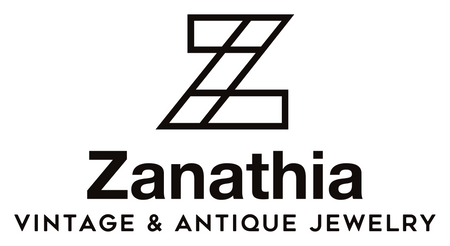Historically, the region of the Czech Republic has been well known for its high-quality glass craftsmanship and substantial Czech crystal deposits. Before Czechoslovakia became a country in 1918, the region was previously known as Bohemia. Factories produced and exported glassware, glass stones, crystal, and beads. During the Victorian Era, Bohemian garnet was a popular costume jewelry choice and mass-produced in various designs. Bohemian garnet was exported from Bohemia beginning in the Middle Ages. The beautiful semiprecious gem was routinely mined in Bohemia and considered one of the highest quality garnets.

(Antique Victorian Era Bohemian Garnet Beaded Necklace Available At Zanathia Jewelry. Bohemian Garnet Originates From Bohemia, Which Was Dissolved and Became Czechoslovakia in 1918. Bohemian Garnet Was A Very Popular Costume Jewelry Choice During The Victorian Era.)

(Antique Sears, Roebuck, and Company Jewelry Catalog Featuring Bohemian Garnet Styles. Catalog Number 124)
The region has been routinely known for innovating and producing quality costume jewelry. Austrian jeweler, Daniel Swarovski (1862-1956), mastered crystal cutting and patented an electric cutting machine that assisted with the production of crystal glass jewelry. The crystals greatly imitated diamonds, sapphires, emeralds, and rubies. He created the Swarovski crystal and innovated a mechanical glass cutter in 1892. Soon, Swarovski crystals were being mass produced and became increasingly in demand. After Bohemia became part of the Czech Republic in 1918, Czech glass became a leading jewelry preference and was used to create durable costume jewelry. Czech beads, along with the innovation of the pressed molded glass process in 1860, imitated genuine gemstones such as rubies, sapphires, and emeralds. Other glassmaking factories and companies soon began to imitate Czech glass jewelry worldwide. Most Czech jewelry in the United States was imported before World War II and was created between 1918-1939.
Identifying Czech jewelry can sometimes be challenging, but there are particular distinctions and clues for collecting. Not all Czech jewelry is marked, but some include marks on the clasps, corners, and backings of pieces. A few of the most common hallmarks include “Made In Czechoslovakia,” “Czech-Slovakia,” and “Czechoslovakia.” Art Deco Era Czech jewelry designs were trendy and were often heavily soldered. This process helped to prevent fragmentation and extensive damage. Another distinct characteristic of Czech jewelry involves the delicate filigree links between glass beads and crystals on necklaces.

(Antique Early Art Deco Era Czech Amber glass necklace featuring seed Pearl accents and delicate brass filigree designs. Availed at Zanathia Jewelry.)
Many antique Czech jewelry designs also added semi-precious stones and faceted glass to create a unique piece. When collecting antique Czech jewelry, you’ll find that the base metals used were usually brass, tin, and alloy. A thin layer of gold was applied to specific designs, which included necklaces and earrings.
Identifying authentic Czech glass and crystal jewelry may be challenging due to the many imitated looks that occurred during the 20th century. One key characteristic to look for is hallmark colors that are often combined in Czech jewelry. Amber-brown and green are often used together in Czech glass pieces. Original antique Czech jewelry designs used colored glass to keep Czech glass free of impurities. The primary color groups of antique Czech glass are brown, red, blue, and green.
Czech crystal is heavier than glass due to its 24 percent lead content and distinct physical properties that can be seen when held up in the light. This characteristic can be best described as a “rainbow” like distinction due to the lead content increasing light refraction properties. When closely examining Czech crystal jewelry, this observation can help to identify authentic pieces. Cut Czech glass may not have the same light refraction properties as Czech crystal, but the distinction may not always be obvious. Czech glass can be cut into faceted pieces to increase refraction properties. However, Cut Czech glass is thinner than Czech crystal. This characteristic can be observed in much Czech faceted glass beaded jewelry. 
(Antique Art Deco Era Czech Amber Glass Faceted Beaded Tassel Necklace, Available Now At Zanathia Jewelry)
Although World War II and the German occupation caused many Czech factories that produced costume jewelry to close, many examples still exist presently. Collecting and preserving antique Czech jewelry is more important than ever. Antique Czech jewelry designs are high quality and have been regularly imitated throughout the centuries. In modern times, they own original Czech jewelry created before World War II that is historically significant to preserve.

